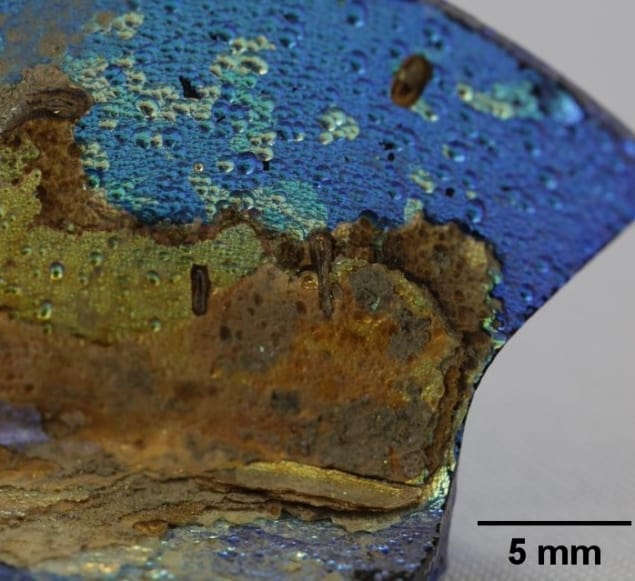
A distinctive iridescent patina on an ancient Roman glass fragment stems from a photonic crystal structure that formed naturally within the material over time, say researchers in Italy and the US. The unusual crystal contains alternating layers of high- and low-density silica layers that resemble reflectors known as Bragg stacks, and their presence makes the fragment’s surface shine like a gold mirror. As well as revealing the nanoscale characteristics of ancient glass, the discovery is an example of naturally-nanofabricated complex photonic architecture – something that could inspire new strategies for producing different glass compositions by artificially ageing them.
Ancient glass artefacts often have iridescent patinas that form gradually by corrosion. This natural process involves the silica particles in the glass repeatedly dissolving and reprecipitating out. The final composition and structure of the patina depends on two factors: reactions between the original constituents in the glass and chemicals in the water-laden soil, and the pH of the water. These reactions restructure the glass into nanometre- to micron-thick layers, or lamellae, that are formed by nanoparticles with regularly alternating packing density. It is these lamellae that give the patina its shine.
In their study, Giulia Guidetti of Tufts University’s Silklab and Roberta Zanini and Giulia Franceschin at the Italian Institute of Technology’s Center for Cultural Heritage Technology (CCHT) chose to analyse a fragment of Roman glass recovered near the ancient city of Aquileia, which is about 100 km northeast of Venice. Thanks to chemical analyses obtained using laser ablation mass spectroscopy, they confirmed the glass was made of silica-soda-lime (which is typical of glass produced in the Roman empire) and dated the sample to between the first century BCE and the first century CE. They then used optical and electron microscopy to characterize the composition of the millimetre-thick patina and found that it shines brightly and reflects light over a broad range of wavelengths.
High-reflectivity Bragg stacks
The researchers say these properties come from stacks of highly ordered nanostructured domains in the patina that individually behave like high-reflectivity Bragg stacks. The collective behaviour of these domains implies that the originally amorphous material has transformed into well-organized photonic crystals through long-term corrosion processes and self-assembly of the silica nanoparticles in the glass. Indeed, apart from the patina, the bulk of the glass remains in its original form and is dark green in colour.
“It is remarkable that such a sophisticated nanostructure, something that photonics researchers and engineers spend a lot of time and effort manufacturing in clean rooms, has formed by being buried in soil for thousands of years,” says Fiorenzo Omenetto, a biomechanical engineer and head of Silklab. “Scientifically, speaking, this process of corrosion may be an inspiration for a different approach to grow ‘structural colours’ and mirrors, provided that the glass transformation was significantly accelerated, of course.”

Are we living in the Age of Glass?
Above all, though, he highlights “the joy of making such an unexpected discovery. This sample was literally sparkling on a shelf, and attracted our attention as we walked past.”
The researchers, who report their work in PNAS, are now working on identifying other ancient glass artefacts with similar characteristics. “While iridescent patinas on ancient glass are relatively common, this particular fragment, characterized as a photonic crystal, presents a unique case,” CCHT director Arianna Traviglia tells Physics World. “Our objective is to further study this phenomenon and understand the environmental conditions that facilitate its occurrence.”
- SEO Powered Content & PR Distribution. Get Amplified Today.
- PlatoData.Network Vertical Generative Ai. Empower Yourself. Access Here.
- PlatoAiStream. Web3 Intelligence. Knowledge Amplified. Access Here.
- PlatoESG. Carbon, CleanTech, Energy, Environment, Solar, Waste Management. Access Here.
- PlatoHealth. Biotech and Clinical Trials Intelligence. Access Here.
- Source: https://physicsworld.com/a/photonic-crystals-formed-over-time-in-ancient-roman-glass/



